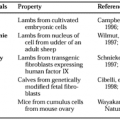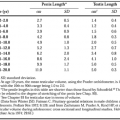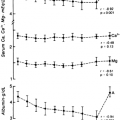PRODUCTION AND METABOLISM OF VITAMIN D
Part of “CHAPTER 54 – VITAMIN D“
PHOTOPRODUCTION
Technically, vitamin D3 is not a true vitamin because it can be produced in the body. Its synthesis in skin can provide the body’s entire requirement unless exposure to sunlight is restricted (see Chap. 185). The reaction proceeds by nonenzymatic photolysis of 7-dehydrocholesterol (provitamin D) in the epidermis.2 Near-ultraviolet (UV) light (wavelengths 290–315 nm) penetrates to the basal layer and cleaves the bond between carbon atoms 9 and 10 of 7-dehydrocholesterol, forming pre-vitamin D3 (see Fig. 54-2). Previtamin D3 and vitamin D3 are in thermal equilibrium; production of the latter is favored at body temperature. The time-dependent thermal isomerization of pre-vitamin D3 to vitamin D3 allows the continuous release of vitamin D3 into the circulation for several days after exposure to sunlight. Previtamin D3 is subject to further photolysis, yielding the biologically inert photoproducts, lumisterol and tachy-sterol. Studies measuring circulating vitamin D3 in subjects who have been given graded amounts of UV light have estimated that exposure to one minimal erythema dose results in the formation of at least 30 μg of vitamin D3 per square meter of body surface. The skin pigment melanin, when present in large amounts, competes with 7-dehydrocholesterol for absorption of UV energy. Thus, heavily pigmented black persons make less vitamin D3 in response to UV exposure than do lightly pigmented white persons.
DIETARY SOURCES
Few foods naturally contain appreciable amounts of vitamin D. The livers of fatty fish are a relatively rich source,2a which accounts for the efficacy of cod-liver oil as a cure for rickets. Insignificant amounts of vitamin D exist naturally in dairy products. The limited dietary availability of vitamin D led to its use as a supplement in certain foods. In the United States, federal regulation stipulates that 10 μg (400 IU) of vitamin D be added to every quart of milk. (In the United Kingdom, milk is not fortified with vitamin D, which may partly explain the lower vitamin D stores of its residents.) Multivitamin preparations typically contain 10 μg, which is twice the recommended dietary allowance of vitamin D as noted by the National Academy of Sciences. It has been estimated that the true vitamin D requirement in the absence of sunlight exposure could be as much as 600 IU or 15 μg per day.3 Previously, the exclusive use of vitamin D2 as a food additive made it the source of the circulating metabolites. Today,
however, either vitamin D2 or vitamin D3 is added to foods, so that vitamin D3 metabolites in the circulation may have originated from endogenous or from dietary sources.
however, either vitamin D2 or vitamin D3 is added to foods, so that vitamin D3 metabolites in the circulation may have originated from endogenous or from dietary sources.
METABOLIC ACTIVATION OF VITAMIN D
Vitamin D has little, if any, intrinsic bioactivity. Sequential hydroxylation reactions, which occur first in the liver and then in the kidney, are required for the production of the biologically active form, 1,25-dihydroxyvitamin D (1,25[OH]2D).1 The addition of the two hydroxyl groups enables 1,25(OH)2D to bind to intracellular receptors in target tissues with high affinity. The metabolism and mode of action of vitamin D, therefore, are similar to those of other steroid hormones.
25-HYDROXYLATION IN THE LIVER
Stay updated, free articles. Join our Telegram channel

Full access? Get Clinical Tree






